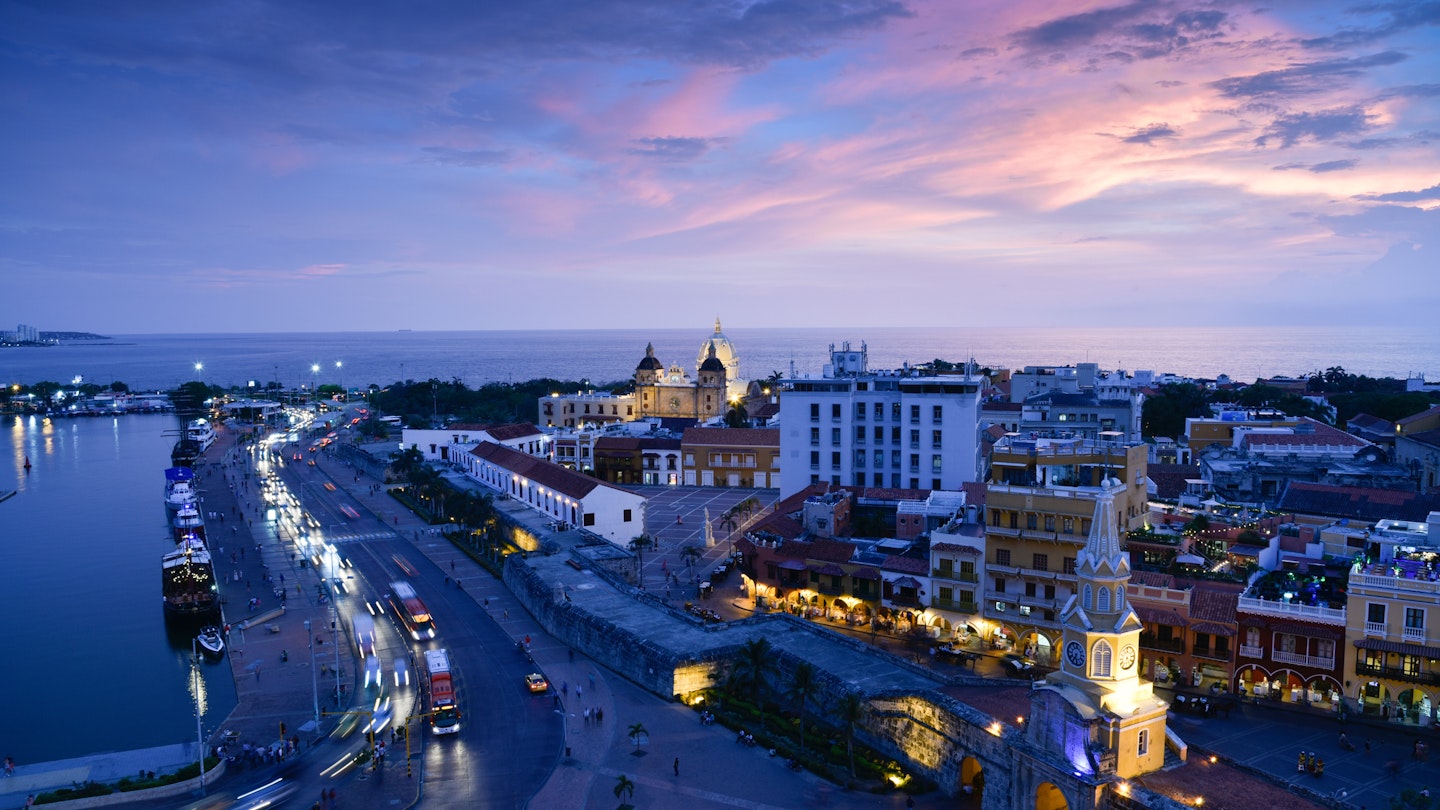Getting Around Cartagena: Your Ultimate Transportation Guide
Cartagena is one of Colombia’s easiest cities to navigate.
The well-preserved historic center and neighboring barrios invite exploration on foot, leading you through the picturesque streets, hidden alleys, and captivating plazas like a seasoned dance partner. Should you desire a swifter pace, though, an array of transportation options are readily available to whisk you away, including taxis, buses, and Uber or other ride-hailing apps.

Wander through Cartagena’s Historic Neighborhoods on Foot
Walking is one of the best ways to get to know Cartagena’s historic center, a pedestrian-friendly paradise separated from the rest of the modern city by a thick stone wall. It would only take 20 minutes to cross the Old Town on foot if it weren’t for the myriad of worthy attractions to see. In fact, most of Cartagena’s top sites can be found here or just outside Las Murrallas (the wall).
Neighboring Getsemaní, located just east of the Old Town’s Torre del Reloj, is just as walkable. Traditionally an enclave of the working class, the barrio has transformed into a trendy district full of boutique hotels, restaurants, and cafes. At every turn, the streets and narrow alleyways unveil colorful murals, flags, kites, umbrellas, and lights strung overhead.
Tips for Walking Around Cartagena:
- Head out early in the morning or late in the afternoon to avoid the searing heat of the midday sun.
- If you don’t have a hat or drinking water, you’ll find plenty of vendors selling both.
- Keep your valuables hidden from view and opt for a taxi late at night.
Get There Quicker by Hailing a Taxi
Taxis are the easiest and quickest way to get around Cartagena. Unlike other big cities in Colombia, it is considered safe to hail an official taxi on the streets of Cartagena; however, when in doubt, have someone at a hotel or restaurant summon one for you. Official taxis are yellow, printed with the words “Servicio Publico,” and the license plate number is affixed to the side passenger door.
As of March 2023, the minimum fare for travel around the historic center is COP$8800, while a taxi from the airport to hotels in the Old Town is COP$14500. Additional fees are levied for rides late at night. While tipping is not expected, rounding up to the nearest thousand pesos is common practice.
Ride-Hailing Apps: Safe and Reliable in Cartagena
Uber can be used in major Colombian cities, including Cartagena; however, it’s only one of many app-based services that get you from point A to B. Other apps such as Cabify, InDriver, and DiDi Rider are popular with locals due to their competitive fares. Regardless of preference, these ride-hailing apps come with security features that allow you to share the driver’s name, vehicle type, and license plate number, as well as your real-time location with someone you know.

Get Everywhere You Need to Go with Buses
Cartagena’s modern bus system consists of four main routes and a series of feeder lines. The orange and white TransCaribe buses operate on dedicated lanes and clean-burning compressed natural gas. These buses circulate from 6 am to 11 pm Monday through Friday, and weekends until 9 pm.
Each ride costs COP$3000; however, no cash is accepted. You will need a rechargeable TuLlave card which can be purchased at TransCaribe stations for COP $6000. Sample routes include the T102 from the airport and the T103 which skirts the Old Town.
Hop on a Sightseeing Bus
Cartagena offers a hop-on, hop-off double-decker bus service that cruises past 14 different tourist sites during its 90-minute loop around the historic center, Bocagrande, Castillogrande, Getsemaní, and Manga neighborhoods. An all-day adult ticket costs US$17, but the two-day pass for US$27 is a better value. Passengers can enjoy a walking tour of the walled city and free entry to local attractions.

Head to Nearby Islands on a Boat
Traveling by boat is essential for reaching notable destinations near Cartagena. Located on the waterfront near the Old Town, the Muelle de la Bodeguita is the departure point for boats to popular spots like the Islas del Rosario and Playa Blanca. Avoid vendors selling package tours and go directly to the ticket office for your tickets.
Offers to Tierra Bomba can be found at the beach; however, be prepared to negotiate prices for roundtrip transportation. A reasonable cost should be around COP$20,000.
Rent a Car Only if You’re Planning to Venture Beyond Cartagena
Getting around Cartagena is easy with public transportation; however, if you prefer to drive or explore beyond the city, Rafael Núñez International Airport is where to rent a car. As long as your home country’s driver’s license uses the Roman alphabet, no international driver’s license is required.
Driving in Cartagena, and Colombia in general, can be hectic with the number of motorcycles on the roads. Therefore, it’s advisable to drive with caution, especially at night.
Cartagena Transportation FAQs and Things to Consider
Is It Safe to Walk Around Cartagena?
Cartagena is considered one of the safest cities in Colombia. The Old Town, Getsemaní, and nearby neighborhoods are generally well-patrolled. However, petty theft can occur, so it’s wise to keep valuables out of sight.
Are Taxis Safe in Cartagena?
You can safely hail a taxi on the street in Cartagena. Licensed taxis are yellow and marked with “servicio publico.” Always negotiate the fare before getting in.
Should I Rent a Car?
If you’re staying in Cartagena, renting a car is not necessary due to better transportation options available.
Are Ride-Hailing Apps Legal?
Ride-hailing services like Uber face challenges in Colombia; however, they operate legally without specific prohibitions. Riders should be cautious and prefer to utilize reputable apps.
Accessible Transportation in Cartagena
Getting around Cartagena can be challenging for travelers with mobility issues, given the city’s uneven surfaces and lack of ramps. Some buses are equipped to accommodate wheelchair users, but private transportation may be necessary for those with motorized wheelchairs.





